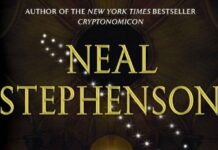
Ebook Info
- Published: 2009
- Number of pages: 1168 pages
- Format: Epub
- File Size: 1.71 MB
- Authors: Neal Stephenson
Description
With this extraordinary first volume in what promises to be an epoch-making masterpiece, Neal Stephenson hacks into the secret histories of nations and the private obsessions of men, decrypting with dazzling virtuosity the forces that shaped this century. As an added bonus, the e-book edition of this New York Times bestseller includes an excerpt from Stephenson’s new novel, Seveneves.
In 1942, Lawrence Pritchard Waterhouse—mathematical genius and young Captain in the U.S. Navy—is assigned to detachment 2702. It is an outfit so secret that only a handful of people know it exists, and some of those people have names like Churchill and Roosevelt. The mission of Waterhouse and Detachment 2702—commanded by Marine Raider Bobby Shaftoe-is to keep the Nazis ignorant of the fact that Allied Intelligence has cracked the enemy’s fabled Enigma code. It is a game, a cryptographic chess match between Waterhouse and his German counterpart, translated into action by the gung-ho Shaftoe and his forces.
Fast-forward to the present, where Waterhouse’s crypto-hacker grandson, Randy, is attempting to create a “data haven” in Southeast Asia—a place where encrypted data can be stored and exchanged free of repression and scrutiny. As governments and multinationals attack the endeavor, Randy joins forces with Shaftoe’s tough-as-nails granddaughter, Amy, to secretly salvage a sunken Nazi submarine that holds the key to keeping the dream of a data haven afloat. But soon their scheme brings to light a massive conspiracy with its roots in Detachment 2702 linked to an unbreakable Nazi code called Arethusa. And it will represent the path to unimaginable riches and a future of personal and digital liberty…or to universal totalitarianism reborn.
A breathtaking tour de force, and Neal Stephenson’s most accomplished and affecting work to date, Cryptonomicon is profound and prophetic, hypnotic and hyper-driven, as it leaps forward and back between World War II and the World Wide Web, hinting all the while at a dark day-after-tomorrow. It is a work of great art, thought and creative daring; the product of a truly iconoclastic imagination working with white-hot intensity.
User’s Reviews
Amazon.com Review Neal Stephenson enjoys cult status among science fiction fans and techie types thanks to Snow Crash, which so completely redefined conventional notions of the high-tech future that it became a self-fulfilling prophecy. But if his cyberpunk classic was big, Cryptonomicon is huge… gargantuan… massive, not just in size (a hefty 918 pages including appendices) but in scope and appeal. It’s the hip, readable heir to Gravity’s Rainbow and the Illuminatus trilogy. And it’s only the first of a proposed series–for more information, read our interview with Stephenson. Cryptonomicon zooms all over the world, careening conspiratorially back and forth between two time periods–World War II and the present. Our 1940s heroes are the brilliant mathematician Lawrence Waterhouse, cryptanalyst extraordinaire, and gung ho, morphine-addicted marine Bobby Shaftoe. They’re part of Detachment 2702, an Allied group trying to break Axis communication codes while simultaneously preventing the enemy from figuring out that their codes have been broken. Their job boils down to layer upon layer of deception. Dr. Alan Turing is also a member of 2702, and he explains the unit’s strange workings to Waterhouse. “When we want to sink a convoy, we send out an observation plane first…. Of course, to observe is not its real duty–we already know exactly where the convoy is. Its real duty is to be observed…. Then, when we come round and sink them, the Germans will not find it suspicious.” All of this secrecy resonates in the present-day story line, in which the grandchildren of the WWII heroes–inimitable programming geek Randy Waterhouse and the lovely and powerful Amy Shaftoe–team up to help create an offshore data haven in Southeast Asia and maybe uncover some gold once destined for Nazi coffers. To top off the paranoiac tone of the book, the mysterious Enoch Root, key member of Detachment 2702 and the Societas Eruditorum, pops up with an unbreakable encryption scheme left over from WWII to befuddle the 1990s protagonists with conspiratorial ties. Cryptonomicon is vintage Stephenson from start to finish: short on plot, but long on detail so precise it’s exhausting. Every page has a math problem, a quotable in-joke, an amazing idea, or a bit of sharp prose. Cryptonomicon is also packed with truly weird characters, funky tech, and crypto–all the crypto you’ll ever need, in fact, not to mention all the computer jargon of the moment. A word to the wise: if you read this book in one sitting, you may die of information overload (and starvation). –Therese Littleton –This text refers to an out of print or unavailable edition of this title. From Kirkus Reviews Stephenson’s prodigious new yarn (after The Diamond Age, 1995, etc.) whirls from WWII cryptography and top-secret bullion shipments to a present-day quest by computer whizzes to build a data haven amid corporate shark-infested waters, by way of multiple present-tense narratives overlaid with creeping paranoia. In 1942, phenomenally talented cryptanalyst Lawrence Waterhouse is plucked from the ruins of Pearl Harbor and posted to Bletchley Park, England, center of Allied code-breaking operations. Problem: having broken the highest German and Japanese codes, how can the Allies use the information without revealing by their actions that the codes have been broken? Enter US Marine Raider Bobby Shaftoe, specialist in cleanup details, statistical adjustments, and dirty jobs. In the present, meanwhile, Waterhouse’s grandson, the computer-encryption whiz Randy, tries to set up a data haven in Southeast Asia, one secure from corporate rivals, nosy governments, and inquisitive intelligence services. He teams up with Shaftoe’s stunning granddaughter, Amy, while pondering mysterious, e-mails from root@eruditorum.org, who’s developed a weird but effective encoding algorithm. Everything, of course, eventually links together. During WWII, Waterhouse and Shaftoe investigate a wrecked U-boat, discovering a consignment of Chinese gold bars, and sheets of a new, indecipherable code. Code-named Arethusa, this material ends up with Randy, presently beset by enemies like his sometime backer, The Dentist. He finds himself in a Filipino jail accused of drug smuggling, along with Shaftoe’s old associate, Enoch Root (root@eruditorum.org!). Since his jailers give him his laptop back, he knows someone’s listening. So he uses his computing skills to confuse the eavesdroppers, decodes Arethusa, and learns the location of a huge hoard of gold looted from Asia by the Japanese. Detail-packed, uninhibitedly discursive, with dollops of heavy-handed humor, and set forth in the author’s usual vainglorious style; still, there’s surprisingly little actual plot. And the huge chunks of baldly technical material might fascinate NSA chiefs, computer nerds, and budding entrepreneurs, but ordinary readers are likely to balk: showtime, with lumps. (Author tour) — Copyright ©1999, Kirkus Associates, LP. All rights reserved. –This text refers to an out of print or unavailable edition of this title. From Booklist Stephenson follows his startlingly original Snow Crash (1992) and The Diamond Age (1995) with proof that he can do as well at twice the page-count, and not only that, but with the promise that this immense volume begins a saga that may rival Robert Jordan’s Wheel of Time in its eventual proportions. Volume one, then, is the well-told tale of a World War II code breaker whose descendants end up trying to track down the secrets of the Third Reich’s cryptographers–secrets that may liberate or ruin the cybertech world of the present day. Stephenson mixes historical and contemporary settings, handling both with great skill, as he presents a large cast of vividly imagined characters, notably including the original code breaker’s granddaughter, and makes both the tale’s technology and its conspiracies highly believable. His choice to tell the entire story in the present tense rather calls attention to itself, and, given a book nearly 1,000 pages long, every word is not really essential. Still, this is a book that should be bought for the sake of saying that you have it and read, however long that takes, for the pleasure and intellectual stimulation it is likely to give to most readers. Imagine Tom Clancy turning to cyberpunk, and you have some idea of its broad potential appeal. Roland Green –This text refers to an out of print or unavailable edition of this title. From Library Journal Computer expert Randy Waterhouse spearheads a movement to create a safe haven for data in a world where information equals power and big business and government seek to control the flow of knowledge. His ambitions collide with a top-secret conspiracy with links to the encryption wars of World War II and his grandfather’s work in preventing the Nazis from discovering that the Allies had cracked their supposedly unbreakable Enigma code. The author of Snow Crash (LJ 4/1/92) focuses his eclectic vision on a story of epic proportions, encompassing both the beginnings of information technology in the 1940s and the blossoming of the present cybertech revolution. Stephenson’s freewheeling prose and ironic voice lend a sense of familiarity to a story that transcends the genre and demands a wide readership among fans of technothrillers as well as a general audience. Highly recommended. Copyright 1999 Reed Business Information, Inc. –This text refers to an out of print or unavailable edition of this title.
Reviews from Amazon users, collected at the time the book is getting published on UniedVRG. It can be related to shiping or paper quality instead of the book content:
⭐ I purchased this book with a high level of interest and expectation. I am reluctant to give only three stars for this work because it is an amazingly well imagined story that combines both a real and a fictional history of cryptography, World War II and near-current day cyber security. This book is a work of nearly one thousand pages which involves a host of different characters spanning an historical time period between approximately World War II through the late 1990’s. Most of the book’s characters are related to one and other trans-generationally across this time period and several of these characters share similar names. This element is both interesting and confusing at times for the reader. I gave this book only three stars because the plot is overly complex and hard to follow. Neal Stephenson’s writing style is also very intricate which makes reading the story heavy and laborious. I am not a particularly fast reader, but even with that, It took me several months to finish this book simply because there were times when I simply didn’t have the stamina to slog through the author’s prose. Several times, I thought about giving up finishing this book, but ended up thinking that finishing it was a quest that I did not want to abandon. The story depicted in the book is in part at least, a quest, and the fact that I was determined to finish it says something good about the book’s overall quality. So, on a positive note, anyone considering taking it on will likely feel rewarded at the end. But let the reader beware, this is not a light read, which may well be worth your time if you can appreciate the author’s unique writing style. For myself, I never really was able to appreciate the author’s writing style in a way that made reading it enjoyable for me, which I think is the true measure of a good book.
⭐ I find it difficult to believe I could like this book any more than I do. I’ve tried to read other works from Mr. Stephenson in the past and I found them unreadable, mostly because I picked them with an expectation of some science or fantasy, or some combination of both. That was my bad. I approached this book with a completely open mind which allowed me to become involved with these incredible characters right from the start. This is a great book. The plot is incredibly involved, deep in math knowledge and World War 2 intrigue, and filled with a cast of incredibly complex yet very approachable characters.
⭐ This is one of the finest books I’ve ever read, and I’ve read a lot, from pulp to classics. It should definitely be on the list of “several hundred books you should read before you die.” It is highly entertaining, extremely well written, and fast moving from start to finish. But it is literature; if the author had lived in the 19th century, he’d have been rubbing sleeves with Mark Twain and Charles Dickens. He’s that good. When I search for contemporary examples similar is originality, skill, and scope, what comes to minds is “We, The Drowned” by Carsten Jensen.The thread running through the book is cryptography, during WWII and in the modern era as computer encryption and hacking to circumvent it. The book gives good historical insight into the massive contribution Allied cryptographers made to the war effort in breaking German and Japanese codes, and into the difficulty of concealing from the enemy the fact that these codes had been broken. The historical and present-day periods are linked in that the characters in WWII are either still alive in the present-day part of the story, or are the grandparents of the present-day characters. I found the main characters in the book to be believable and well developed. There are mildly technical descriptions of coding and codebreaking throughout the book that are, however, geared to the lay reader and can be read or skimmed according to the reader’s inclinations. I personally found them readable and interesting. The book also gives an insight into how mathematicians’ minds work, with humerous illutrations such as one of the WWII characters mathematically characterizing the ‘Horniness Index’ as it applies to a young woman he’s fallen in love with and the effect of this on his work. Sketches like this were simply fun to read. Overall, the book deals with serious issues, but the underling tone throughout is one of wry humor.Caution: Don’t pick up this book unless you have a good chunk of time. It is over 1000 pages of addictive reading.
⭐ What I liked best about this book is how he delves into the characters’ behaviors and almost compulsively analytical thoughts. I liked it, because as an engineer who has done programming in the past (before I retired), I saw a lot of myself in some of the characters. I have to think that only a compulsive author would know enough about these things to write such a book, so I applaud that part.What I didn’t like about the book is how he often took a sidebar idea, which was meant to show a reference to a character’s past, and just went on for pages and pages down a rat hole. At first, the sidebar was helpful in defining how an event shaped the present, but he went into WAY too much detail (i.e., the author was very compulsive), and in so doing, lost me a number of times – to the point where I would start skimming pages to get back to the main story line. For example, more than once, he went on for pages showing ASCI code and how it might be interpreted – which could have been done in a very short example that did not last for pages. He also spent more time that I think necessary discussing how the character calculated the value of sexual release on his productivity – I found that section interesting (because I could actually understand what he was saying), but it went on too long – pages and pages. A shorter sidebar would have helped the flow of the book.So while I like the book overall, it could have been a lot better if he had not gone so far down so many ratholes… I would love to read this author again – if he summarized the sidebars a little more, and didn’t deviate from the main plot as much. I also would like to have a bit easier way to judge what era a chapter is in – the entire book jumps back and forth from WWII to more or less present day – but you often have to get several sentences in to a chapter to know which era this chapter is about. A simple title at the top of a chapter would help a lot.
⭐ Stephenson might be the smartest person writing fiction today. He has some of the most imaginative books out there, including futuristic and in some cases prophetic works such as The Diamond Age: Or, a Young Lady’s Illustrated Primer (Bantam Spectra Book) .This is a good introduction to Stephenson. It’s set in current times (actually more turn of the century, being published in 1999), with parts also set in WWII. It deals with interesting issues of war, computing, and economics. It ties together disparate story lines so that they come together beautifully in the end.There’s action, characters you’ll root for, intrigue, and prose that’s magnificent. Stephenson is one of the few writers that makes me sometimes stop and re-read a sentence just because of its sheer artistry.If I had to make a criticism, it’s this: as brilliant a writer as Stephenson is, he tends towards abrupt endings that feel like he just got tired of the story and wrapped it up in a hurry. But this is a tiny price to pay in a book this good.
⭐ It won some Science Fiction prizes, but in reading it I’d say there is not much science fiction. Instead there’s a fair bit of science fact, mathematics/cryptography principles (taught by the way), historical fact and mis-en-scene (and historical fiction/drama), and a bit of futurist thinking (i.e. before bitcoin was invented, Stephenson in effect proposes something like it, except for it would be backed by gold, which bitcoin is not). What is uniquely entertaining is that Stephenson weaves actual famous historical figures into the story, and although it is clearly fiction, you get the sense that what these people did and how they interacted is quite plausible, because Stephenson of course bases their actions and personalities in what is known about these persons.The other thing I like about this story is the fast paced, adventurous, and far-fetched situations the characters get into. One character is introduced by way of a survival story, where over the course of a couple days or weeks he survives against the most ridiculous odds, over and over again… and yet Stephenson manages to suspend your disbelief the whole way through.There is also lots of humor.There is very little sexual content in one part of the story, developing one of the characters. It is not graphic.The violence is sprinkled in here and there, mostly in the WWII part of the story. It is not central to the story, but certainly serves illustrating the intense situations you might find yourself in in wartime.If your interests tend toward tech and history and adventure, you’ll love this book.I am now reading Stephenson’s prequel Quicksilver (written after Cryptonomicon), set in pre-revolutionary Boston and the European Enlightenment. The same entertaining style but in a more slowly moving story loosely including a cast of giants (Ben Franklin, Isaac Asimov, etc.)
⭐ I’ve read other books by this author and have enjoyed them. Unfortunately, this book was just not meant for me. It was a rather dry and boring read, to be honest. It felt more academic than not, often dedicating pages and pages and pages to mathematical theories and equations. It also had a tendency to go off on some bizarre tangents into things that had little to do with the characters or plot. I’m all for an immersive setting, but these passages were just plain unnecessary.If you’re going to read this, I hope you’re really into math. Really, really into math.
⭐ I’ve read much of Neal Stephenson’s work, most of it in the science fiction/cyberpunk genre. I have found those novels to be extremely well written, usually creating an entirely new culture and requiring a certain level of concentration and attention to follow. Make no mistake; Neal Stephenson is one very smart fellow.A couple of years ago, he penned a “thriller” titled Reamde, which I felt was an abysmal failure. I put it off to a departure from his sci-fi/cyberpunk roots, unaware that he had written a prior novel outside the genre, Cryptonomicon.This work is a real doorstop, clocking in at about 1,140 pages. It follows two distinct timelines involving generations of the Shaftoe and Waterhouse families, World War II crypto-analysis, modern day (at the time it was written) telecommunications technology and search for hidden treasure centered in Indonesia/Southeast Asia.Unlike Reamde, which I felt involved absurd and ridiculous scenarios and activities, the events in this novel are extremely realistic, inasmuch as they are based upon actual code breaking activity that took place in World War II. While there are sections which get a little deep in code theory, they don’t go so deep as to completely swamp the novice reader.While the first couple of hundred pages act to set the stage, what follows is quite simply magnificent, both with respect to the quality of the writing and the educational value of the contents. Around the 2/3 mark of the book, you begin to see the threads coming together in a fascinating manner.This is quite simply one of the best novels I’ve ever read.
⭐ This is the fourth book I’ve read by the author. I have enjoyed them all. The others all took place in an imagined future (snow crash, anathem, seven eves) but this takes place in “the present” and during WWII.I learned quite a bit about the pacific theatre during the war and the role of cryptography and code breaking that went into the allied victory. I don’t know how much is historically accurate but given the author’s technical accuracy I imagine the history is well researched.Highly recommend.
⭐ There’s no point trying to describe it. More erudite than me have called it Gravuty’s Rainbow for the digital age or some such worthy accolade. I just love a great story packed with humour action intelligence and interesting facts, shot through with a lexicon that occasionally requires resort to the dictionary (lot more convenient with Kindle than dead tree version) but leaves one with the satisfied feeling of having cracked a new nut in the code of language philology whatever and a toothsome morsel resides ever within. Have squirrelled away many of his other works including the brilliant SevenEves since and whether re-reading them from cover to cover every few years or occasionally dipping in and finding a well loved passage chapter exposition or whatever it’s well worth it. Once or twice only have I felt he might have gotten busy with the blue pencil but sure that’s only envy on my part. As GB Shaw said once apologising for the prolixity of his writing “I hadn’t time to be more concise” and with his output prodigious neither clearly has Neal Stephenson and we’re all the better for it.
Keywords
Free Download Cryptonomicon in Epub format
Cryptonomicon Epub Free Download
Download Cryptonomicon 2009 Epub Free
Cryptonomicon 2009 Epub Free Download
Download Cryptonomicon Epub
Free Download Ebook Cryptonomicon




